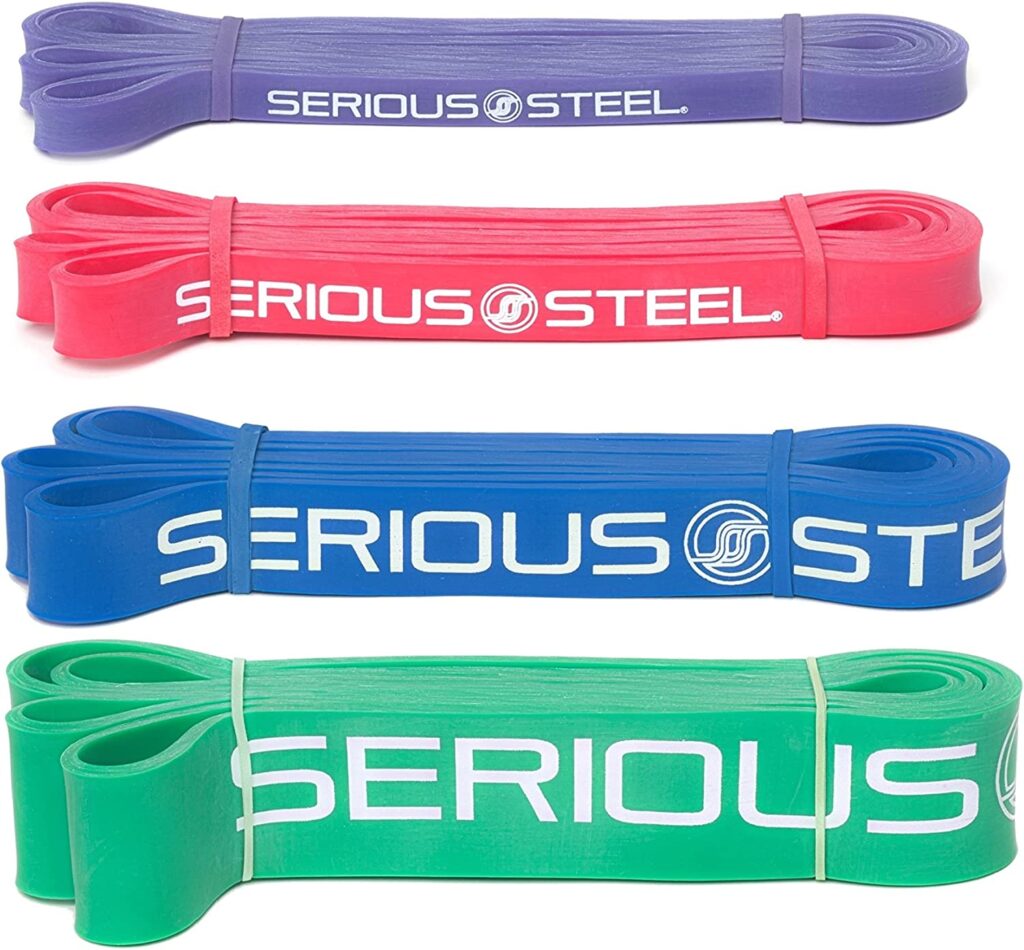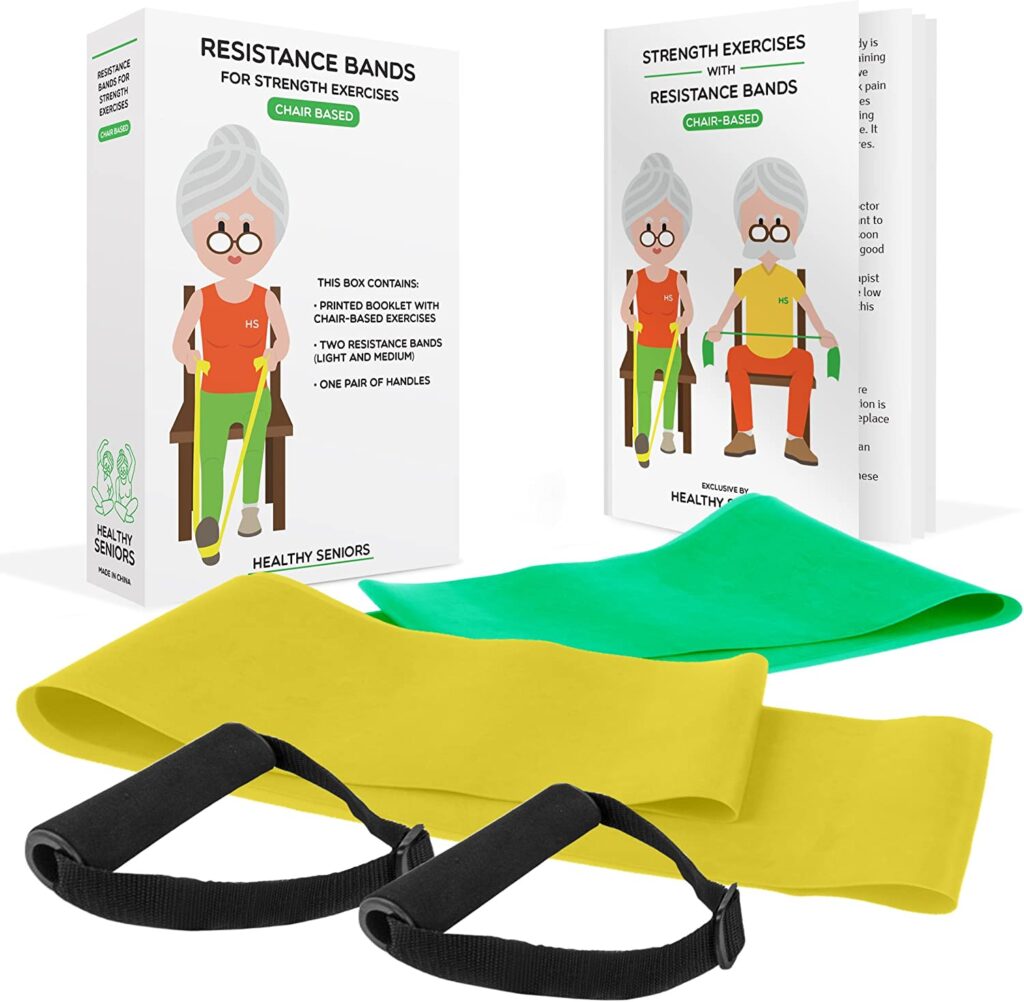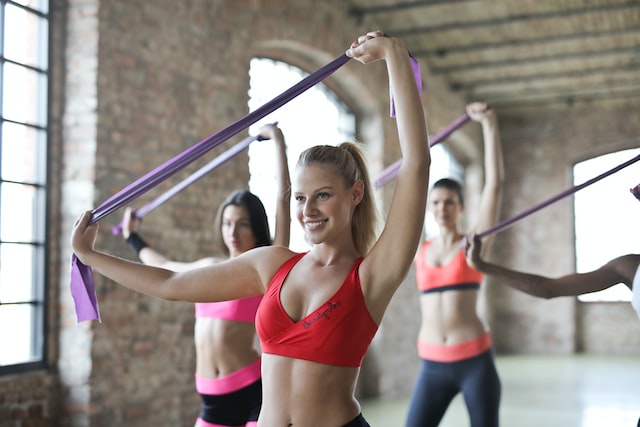Here are rest of the resistance bands we recommend on our list.
This post contains referral links for products we love. Staying Fit With Aeran earns a small commission on these links at no cost to you, and the links will always be marked with an asterisk *.
Serious Steel *Assisted Pull-up BandBest Power/Assist Bands
Pros
- Resistance levels are clearly labeled
- There will be no sliding with moist or dry hands
- Four bands for all skill levels
Cons
- Other sets are more portable
- There is a lack of versatility
Loop bands and tube bands are great for total-body workouts. However, Serious Steel’s Assisted Pull-Up Bands are our top selection for improving your pull-up skills.
Power bands are designed to be used with your own body weight and differ from other types of resistance bands. They are longer, thicker, and made for the heavy-weight application. We found them to be excellent for pull-ups. Because of their harder composition, they weren’t perfect for activities like bicep curls or squats.

Serious Steel’s kit contained four bands with varied resistance options. This allowed testers of all skill levels to utilize the bands safely. One of our testers mentioned that she loved being able to start with an easier band that provided more resistance during her pull-ups. She was able to progress to a band that provided less difficulty (almost mimicking a bodyweight pull-up).
The bands seemed robust on both wet and dry skin. They didn’t feel like they’d snap back at any point during the test. We believe that an included instruction guide would have been useful for training assistance. We also liked that the bands were color-coded based on resistance levels. It made it easier to select the best one for a specific exercise.
Healthy Elderly Chair * Workout Program with Two Resistance BandsBest Resistance Straps
Pros
- Excellent for chair workouts
- Written instructions were provided
- A video tutorial is given
Cons
- Bands may slip if not properly fastened
- Handles are difficult to attach to bands
The majority of the bands on our list are intended for heavy lifting and medium- to high-intensity workouts. Healthy Seniors’ Bands, on the other hand, are lightweight and ideal for seated workouts and stretches. The 18-page handbook that came with these straps was very instructive and easy to grasp and read, making it an excellent choice for novices.
While none of our testers are “older adults,” we did notice that the instruction guide, which includes low-impact chair exercises, may appeal to elderly exercisers or those with physical restrictions more than others on the market. Because they are lighter and easier to use, these bands are also excellent workout tools for people who have knee issues.

You will find two bands labeled “light” and “medium” within the set’s box, and they were simple to use both alone and with the included handles. But, when the bands are loosely knotted around the handles, they can snap back. This problem was solved in the lab by double-knotting the bands instead.
The sturdy handles and straps made it simple to perform squats, bicep curls, and hamstring stretches with this set. Without further testing, we can’t say much about long-term durability, although the latex construction should withstand repetitive stretching and ongoing use. These bands didn’t come with a bag, but they were light enough to carry in a gym bag.
How We Chosen and Tested Resistant Bands
We had some trainers assist us in deciding which resistance bands to test. They demonstrated how resistance bands could be used to offer a safe and effective workout. They also advised us on what elements to seek while selecting high-quality, low-cost bands.
During testing, we focused on a number of factors, including quality, measuring accuracy, adaptability, feel and grip, and portability and storage.
We calculated an overall rating for each group of bands by averaging the scores of these six attributes. Because some bands scored high in one feature category but low in another—for example, excellent portability but low adaptability for single band sets—none of the resistance bands we examined achieved a perfect overall score.
Prior to putting the bands through their paces, we weighed and measured them, taking note of any odors, durability issues, or wear and tear.
Seven testers, including a trained barre instructor and a certified personal trainer, used the bands for two days and around 16 hours. With each loop band, we did squats, lateral walks, and clamshells. We performed many reps of bicep curls, rows, shoulder presses, and shoulder/chest stretches to put tube bands to the test.
We put the resistance straps through their paces by performing squats, split-stance shoulder presses, and hamstring stretches. Finally, we used the power/assist bands in performing pull-ups and one-arm bicep curls. If ankle straps were provided, we also conducted hip adduction and abduction exercises, and other equipment were used as recommended.
Moisture Test
After finishing each workout, we wet our hands and legs with water to simulate if used on sweaty skin or in a humid atmosphere. Following the dry and wet activity testing, we re-evaluated the bands by inspecting their surface and stretching them to check if there was any wear. The bands and accessories that come with carrying bags were packed into the bags to test if they all fit comfortably for easy transport.
Although the quality of the bands was noticed throughout the two days of lab testing, our testers continue to use the resistance bands at home to see how they withstand wear and tear over time.
Things to Look for When Purchasing a Resistance Bands
Style
Not sure which resistance band style is best for you? “Consider how you want to include resistance bands into your workouts. That should help you select which sort to use.
A loop band may be the finest way to challenge yourself during glute and leg workouts. We found you’ll be better off buying a tube band, such as those in Whatafit’s Resistance Bands Set, for arm exercises. While loop and tube bands are especially useful for specific activities. They’re also versatile and can be used in a total-body workout.

If you choose a power/assist band, such as Serious Steel’s Assisted Pull-Up Band, you’re probably looking to increase your pull-up form or intensity level. These bands are less adaptable, yet they can be used for some types of stretching. Whether you do rehabilitative or low-impact exercises, a resistance strap will give you the most options for use with upper- or lower-body activities.
Almost every set of resistance bands comes with a set of tension levels (light, medium, and heavy) or pounds. Additionally, some manufacturers indicate the resistance tension range for each of their bands rather than merely the set as a whole.
Trainers suggests buying a set with a low tension for lighter upper-body workouts and a high tension for tougher lower-body workout regimens. You won’t have to acquire additional bands to handle different activities with these multi-packs of resistance bands.
Material
The majority of resistance bands, regardless of their kind, are constructed of rubber or latex. These materials are elastic, durable, and simple to clean. Although rubber is more durable, expert notes that latex provides a larger range of stretch for both high- and low-impact exercises.
Though loop bands can be produced from these materials, you may also find some fashioned from fabric, such as RenoJ’s Resistance Bands Set, our top overall recommendation. This is a woven knit material that gives stretch without the risk of pinching or slipping on the skin.
Accessories Provided with Resistance Bands
If you get more accessories with your purchase, you can discover that you can do more workouts with a single set. Handles, ankle straps, and door anchors are some of the most common extras found in a fitness band set.
Handles frequently attach into tube bands using a carabiner clip and provide a secure place to comfortably hold the tubes. Ankle straps are worn loosely across the ankles for movements such as hip adduction and abduction.
You’ll be able to execute rows, kickbacks, and other exercises that need the straps to be fastened to a secure spot more readily if the set includes door anchors.
To Conclude On Resistance Bands
A good set of resistance bands will typically cost between $20 and $80. Inexpensive bands may be less durable, while more expensive versions may have unneeded extras. Insonder’s Resistance Bands Set, the cheapest set on our list, is frequently available for less than $10. When we last updated this list, our most expensive pick, the BC Strong Glute Loop Bundle, was $120.
While resistance bands are frequently utilized in place of free weights, it’s reasonable to ask if they’ll genuinely help you gain strength. But the truth is that they will. Numerous studies have found that working out with resistance bands is an excellent technique for engaging muscles and increasing strength.
Because resistance bands are not the same shape as free weights, they may challenge your muscles in a different way. When similar exercises were conducted, one study discovered that resistance bands engaged some muscles more than free weights and some muscles less than free weights.
